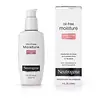What's inside
What's inside
 Key Ingredients
Key Ingredients

 Benefits
Benefits

 Concerns
Concerns

 Ingredients Side-by-side
Ingredients Side-by-side

Salicylic Acid 0.5%
MaskingWater
Skin ConditioningDicaprylyl Ether
EmollientCetearyl Alcohol
EmollientGlycerin
HumectantNeopentyl Glycol Diethylhexanoate
EmollientDimethicone
EmollientMethyl Gluceth-20
HumectantAluminum Starch Octenylsuccinate
AbsorbentCeteth-10 Phosphate
CleansingDicetyl Phosphate
EmulsifyingSteareth-20
CleansingSteareth-2
EmulsifyingNeopentyl Glycol Diisostearate
EmulsifyingSodium Benzoate
MaskingParfum
MaskingSodium Hydroxide
BufferingDisodium EDTA
Xanthan Gum
EmulsifyingMagnesium Aluminum Silicate
AbsorbentBHT
AntioxidantCitrus Grandis Fruit Extract
AstringentSalicylic Acid 0.5%, Water, Dicaprylyl Ether, Cetearyl Alcohol, Glycerin, Neopentyl Glycol Diethylhexanoate, Dimethicone, Methyl Gluceth-20, Aluminum Starch Octenylsuccinate, Ceteth-10 Phosphate, Dicetyl Phosphate, Steareth-20, Steareth-2, Neopentyl Glycol Diisostearate, Sodium Benzoate, Parfum, Sodium Hydroxide, Disodium EDTA, Xanthan Gum, Magnesium Aluminum Silicate, BHT, Citrus Grandis Fruit Extract
Water
Skin ConditioningCyclomethicone
EmollientCetyl Ethylhexanoate
EmollientGlycerin
HumectantCetyl Ricinoleate
EmollientStearyl Alcohol
EmollientGlyceryl Stearate
EmollientPEG-100 Stearate
Methyl Methacrylate
Glycol Dimethacrylate Crosspolymer
Lysine Carboxymethyl Cysteinate
Skin ConditioningLysine Thiazolidine Carboxylate
Skin ConditioningTocopherol
AntioxidantSilica
AbrasiveXanthan Gum
EmulsifyingMethylparaben
PreservativePropylparaben
PreservativeDiazolidinyl Urea
PreservativeBenzalkonium Chloride
AntimicrobialWater, Cyclomethicone, Cetyl Ethylhexanoate, Glycerin, Cetyl Ricinoleate, Stearyl Alcohol, Glyceryl Stearate, PEG-100 Stearate, Methyl Methacrylate, Glycol Dimethacrylate Crosspolymer, Lysine Carboxymethyl Cysteinate, Lysine Thiazolidine Carboxylate, Tocopherol, Silica, Xanthan Gum, Methylparaben, Propylparaben, Diazolidinyl Urea, Benzalkonium Chloride
 Reviews
Reviews

Ingredients Explained
These ingredients are found in both products.
Ingredients higher up in an ingredient list are typically present in a larger amount.
Glycerin is already naturally found in your skin. It helps moisturize and protect your skin.
A study from 2016 found glycerin to be more effective as a humectant than AHAs and hyaluronic acid.
As a humectant, it helps the skin stay hydrated by pulling moisture to your skin. The low molecular weight of glycerin allows it to pull moisture into the deeper layers of your skin.
Hydrated skin improves your skin barrier; Your skin barrier helps protect against irritants and bacteria.
Glycerin has also been found to have antimicrobial and antiviral properties. Due to these properties, glycerin is often used in wound and burn treatments.
In cosmetics, glycerin is usually derived from plants such as soybean or palm. However, it can also be sourced from animals, such as tallow or animal fat.
This ingredient is organic, colorless, odorless, and non-toxic.
Glycerin is the name for this ingredient in American English. British English uses Glycerol/Glycerine.
Learn more about GlycerinWater. It's the most common cosmetic ingredient of all. You'll usually see it at the top of ingredient lists, meaning that it makes up the largest part of the product.
So why is it so popular? Water most often acts as a solvent - this means that it helps dissolve other ingredients into the formulation.
You'll also recognize water as that liquid we all need to stay alive. If you see this, drink a glass of water. Stay hydrated!
Learn more about WaterXanthan gum is used as a stabilizer and thickener within cosmetic products. It helps give products a sticky, thick feeling - preventing them from being too runny.
On the technical side of things, xanthan gum is a polysaccharide - a combination consisting of multiple sugar molecules bonded together.
Xanthan gum is a pretty common and great ingredient. It is a natural, non-toxic, non-irritating ingredient that is also commonly used in food products.
Learn more about Xanthan Gum